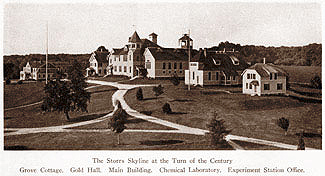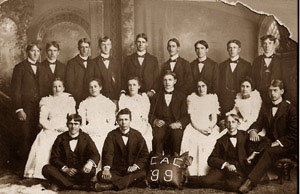|
Connecticut Agricultural College - 1900
Dawn of a New Century
As 1899 was coming to a close, students and faculty in Storrs
were still sensing some excitement about the new name of their college. It
was founded in 1881 as Storrs Agricultural School and renamed in 1893 as Storrs
Agricultural College. During the spring of 1899, that was changed to Connecticut
Agricultural College.
There were 110 students enrolled in the fall of 1899 - 77
men and 33 women, and President George Flint had a faculty of 19 instructors.[See
note 2.] About a dozen wooden structures comprised the CAC campus at that
time -- including the Main Building, which had administrative offices, classrooms,
laboratories, the library and rooms rented to faculty as living quarters. There
were two dormitories: Gold Hall for men and Grove Cottage for women.
In December 1899 there was no mention in the student newspaper
or other documents of a new century approaching. Final exams ended on December
20 and most students headed home for a 12 day vacation before the January 3
start of the winter term of 1900. In the January 1900 issue of the student newspaper, The Lookout (Vol. 4 No. 6), editors led off the monthly "College Notes" column with - 'Hello! What century is this anyhow?' with no further comment about a new century.[See note 5] Calendar purists can take note: many people in 1899 viewed 1900 as the last year of the 19th century. The first year of the new century would be 1901. So, one year later, January, 1901, a member of the Class of 1901 wrote in The Lookout of how the new century was greeted in Connecticut. F. W. Pratt was visiting an uncle in Hartford during the break before the beginning of the winter term in early January:
In the same issue of The Lookout that January are several short essays by students about the new century -- including one by Walter F. Thorpe, a colleague of Pratt's in the senior class at CAC. Thorpe called the century just passed "one of the three greatest centuries that man ever has lived in.
Then, Thorpe makes some predictions - some prophetic, some off-the-mark - for the new 20th century, and how the world may look at the dawn of the 21st:
Another essay on the coming 20th century by another student, C. Foubert, takes a dimmer view of the world:
The dawn of the 20th century was not a good time for CAC -- the college was in the midst a controversy that began in 1898. Known as "The War of the Rebellion," it centered on Pres. George Flint's decision to make agricultural education secondary to classical education. It infuriated some faculty and set off heated exchanges in letters-to-the-editor in newspapers throughout the state. Even the New York Sun took note. The battle ended in 1901 with Flint's forced resignation, but he won the war. Successor Rufus Stimson held the college together -- even bucking a campaign to move the college out of Storrs to either Norwich or New Haven. Stimson's modest changes paved the way for curriculum reforms in 1911 and 1914 by his successor, Charles L. Beach, president from 1908 to 1928.
Mark J. Roy |
||
| Notes: * The chemistry laboratory and experiment station were on the site of what is now the Charles Waring Building near Swan Lake (also known as the Duck Pond), which is just out of the picture to the right. The chemistry lab was destroyed by fire around 1910. The experiment station survived to the 1960s after being moved to a site across from what is now North Campus. It was torn down to make way for the Torrey Life Sciences Building. |

 Class
of 1899
Class
of 1899